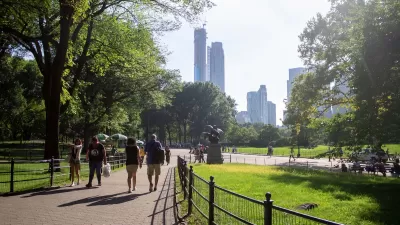For the third installment of his series on America's pedestrian problem, Tom Vanderbilt profiles Walk Score, the venerable walkability website and evaluation system.
For his profile, Vanderbilt ventured to Walk Score's Seattle offices, which by the way earn a healthy, but not ideal, walk score of 80.
"Launched in 2007 as part of a series of 'civic software' initiatives, Walk Score instantly went viral, and quickly become an institution, particularly in the world of real estate. Walk Score numbers are found on every Zillow listing and on more than 10,000 realtor websites nationwide." In addition, its use has become widespread in the planning profession, where its results have become a handy metric for communicating with stakeholders.
For Vanderbilt, the most important success for the website is, "the idea that Walk Score has quantified walkability, taken an abstract quality-you know it when you see it, sort of-and turned it into something that can be measured against other addresses, other neighborhoods, even other cities (witness the New York versus San Francisco World Series of Walking). Walk Score gets people thinking concretely about walking."
"Urban planners have been talking about walkability for a long time, but it's hard to get people to pay attention," says Matt Lerner, Walk Score's CTO. "But because the scores are so personal, it's gotten people to pay attention."
FULL STORY: What’s Your Walk Score?

Manufactured Crisis: Losing the Nation’s Largest Source of Unsubsidized Affordable Housing
Manufactured housing communities have long been an affordable housing option for millions of people living in the U.S., but that affordability is disappearing rapidly. How did we get here?

Americans May Be Stuck — But Why?
Americans are moving a lot less than they once did, and that is a problem. While Yoni Applebaum, in his highly-publicized article Stuck, gets the reasons badly wrong, it's still important to ask: why are we moving so much less than before?

Using Old Oil and Gas Wells for Green Energy Storage
Penn State researchers have found that repurposing abandoned oil and gas wells for geothermal-assisted compressed-air energy storage can boost efficiency, reduce environmental risks, and support clean energy and job transitions.

Minneapolis Bans Rent-Setting Software
Four cities have enacted restrictions on algorithmic software that can inflate rent costs.

Oakland to Add 244 New EV Chargers
Oakland plans to launch its new charging network at eight locations by the end of 2025.

Jane Goodall Inspires with Message of Hope, Resilience, and Environmental Action
Speaking in Pasadena, Jane Goodall offered a hopeful and inspirational message, urging global compassion, environmental responsibility, and the power of individual action to shape a better future.
Urban Design for Planners 1: Software Tools
This six-course series explores essential urban design concepts using open source software and equips planners with the tools they need to participate fully in the urban design process.
Planning for Universal Design
Learn the tools for implementing Universal Design in planning regulations.
Heyer Gruel & Associates PA
City of Moreno Valley
Institute for Housing and Urban Development Studies (IHS)
City of Grandview
Harvard GSD Executive Education
Salt Lake City
NYU Wagner Graduate School of Public Service
City of Cambridge, Maryland





























